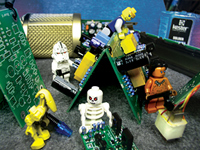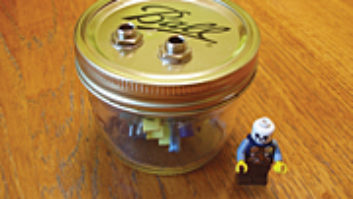
By supplying build-ready printed circuit boards, audio kits offer a way to save money and learn a little in the process.
Illustration: Eddie Ciletti
With the state of today’s economy, it’s hard to predict (or have confidence in) the days ahead. In large part, our industry’s survival has always been driven by its enthusiasts’ pure sonic passion — an artistic energy and bull-headed philosophy that flies in the face of any traditional M.B.A. approach. Looking into my silicon crystal ball, your passion for knowledge and the declining value of a dollar tell me there might be a D.I.Y. kit on your holiday gift list this year. And there are a lot of reasons to love these kits: They teach us almost as much about our retail gear as they do about D.I.Y.
Old Becomes Retro
For years, I had a tube-based stereo system, selected because it was affordable rather than fashionable. My aging systems always needed a little TLC, which was a trade-off (you might even say an investment). Working on “broken stuff” that is typically “old stuff” put many of the technically inclined ahead of the curve when that stuff became “cool stuff.”
As I’ve said many times before, digital audio re-invigorated retro audio, making it inevitable that many maintenance gurus, expat scientists and technically gifted musicians would get into the boutique audio biz. There are even cottage industries based on modifying inexpensive Chinese and Russian goods that need an old-school DNA infusion.
Economic Scale
How does the stuff we buy get priced? Let’s consider what’s involved. Mass-produced items like cell phones and computer circuit boards can be “stuffed” by a pick-and-place machine in minutes.
By contrast, many boutique audio products are still assembled by humans, and even when their circuit boards take advantage of modern production techniques, big, bulky retro audio components — like transformers — must be hand-mounted and soldered (skilled labor). Beyond parts and labor, the bigger chunks of the end-user price tag include other spendy items like the chassis, marketing and retailer mark-up. One way to make high-performance retro-style gear affordable is by building kits, where the most important component is your time commitment.
Tools and Techniques
Success in building any kit requires a good soldering iron and a handful of decent tools. (For some suggestions, see my June 2008 column, http://mixonline.com/studios/business/audio_tools_olde_friends.) You might want to consult the manufacturer as to solder preference, and while we should all be moving away from lead-based solders, they are the easiest to use. Start with a clean, well-lit work area. Follow the instructions as to the order in which the parts are placed on the circuit board. At this point, you may be instructed to bend the “legs” — also known as leads — enough to secure the parts and trim the excess before soldering anything.
For geek newbies, fine motor skills will be the first challenge. For example, the three-step wire-prepping process starts with stripping (removing insulation), twisting (if the wires are stranded) and tinning (applying solder to keep the strands together). Practice on expendable wires before moving on to the kit. In the first step, the goal of the wire-stripper tool is to break the insulation but not nick the wire. It is better to be cautious, so if you don’t cut all the way through the insulation, just bending it should complete the job. Twisting the insulation while removing it will also twist the wire strands underneath, saving a step.
During the tinning process, you’ll notice that the insulation shrinks, so keep this in mind. You will always start with — and want — a little more bare wire than necessary. When it’s time to attach a wire (to a circuit board, connector or switch), it’s important to butt the insulation all the way up to the connection — you don’t want exposed, un-insulated bare wires that might come in contact with other connections.
To avoid internal component damage, use long/needle-nosed pliers to grip the leg near the part’s body before bending. Most electronic components come in two configurations: axial and radial. When placing small-signal transistors (these have a case style known as TO-92), don’t shove them all the way down on the circuit board as this will stress the internal connection. Once placed on the board, bend the leads on the opposite side enough to secure the part while the board is upside down.
Parts with polarity and orientation issues are capacitors, diodes, transistors, ICs and LEDs. Transistors (and voltage regulators) are three-legged devices. While all transistors have a base, emitter and collector, the “leg” order is not always the same. The square TO-220 case style is used for transistors, voltage regulators, diodes and resistors, so be sure to read the part number. Here, a jeweler’s loupe or magnifying glass can make this task easier. LEDs have a long leg (anode = “+”) and a short leg (cathode = “-”). The same convention applies to polarized capacitors. Round LEDs also have a flat spot on the cathode side.
Home Stretch
Scheduling time for your first kit might be challenging, but you’ll be rewarded with improved fine motor skills and a greater awareness of electronic components. You may even find the process mentally therapeutic. So you’ll feel better, save money and learn something in the process — not a bad deal.
Visit Eddie Ciletti online at
www.tangible-technology.com.
Selected Kit Suppliers
ABRA Electronics
Entry-level starter kits
www.abra-electronics.com
Five Fish Studios
Basic audio kits
www.fivefishstudios.com
Hamptone
Classic-style tube and solid-state preamps
www.hamptone.com
JLM Audio
Classic-style preamps and EQs
www.jlmaudio.com
LAZ Pro
500 Series audio modules
www.lazpro.com
Moog Music
Theremin kits
www.moogmusic.com
PAIA Electronics
Electronic music and studio gear kits
www.paia.com
Seventh Circle Audio
Classic-style mic preamp modules
www.seventhcircleaudio.com
AUDIO SCIENCE
ALL ABOUT SOLDER
Solder is an alloy of metals used to bond electronic components together. Tin/lead solders are being phased out in favor of tin/copper/silver to meet RoHS environmental compliance. Flux is a chemical blend that’s either mixed in with the solder or applied to the work to simultaneously remove oxide, thus improving the bond/connection.
Good soldering begins with a high-quality iron, like the temperature-controlled Hakko 936 (about $80 online). The key to quality solder connections is getting “the work” hot enough to melt the solder — approximately 800 degrees F. Keeping the soldering iron tip clean by wiping on a damp cellulose sponge — followed by applying a thin coat of solder to the tip — helps improve heat transfer while extending the tip’s life.
— Eddie Ciletti






